Building A Parallella Cluster
I finally got around to assembling my small pile of Parallella boards into a cluster.
This post documents the choices I made about power distribution, mechanical assembly, cooling, software management, etc. For background on the individual boards, see my previous post: Introduction to Parallella.
The software directions are based on the Linaro 14.04 image. (At some point I should upgrade to the latest Paraubuntu release.)
Power
There are several options for powering multiple boards:
- Solder a jumper and use the mounting pads with metal standoffs to transmit the power. This option requires the fewest cords.
- Use micro USB connector (need to switch jumper J14). There are multi-port USB power supplies that should work. This is probably the simplest option for a small number of boards.
- Use the 5.5mm barrel plug (default settings). There are versions with screw terminals on Amazon (these for example).
I went with option 3 and used an old PC power supply for the power.
Mechanical assembly
I used 20mm nylon standoffs and assembled the boards into two stacks. A small piece of 1/4" plywood was used for the base.
Cooling
For air flow, I used a cooling fan from an old PC and mounted it to the plywood base.
Network
Needing ports for a maximum of 10 boards, plus one port for the external connection, I chose a 16-port Gigabit D-Link switch. Eventually I would like to power the network switch from the PC power supply, but need to get the right plug first.
The nodes use DHCP from my home network get their addresses. A future improvement is to run a DHCP server on one node and use that to supply addresses to the other nodes. This would make the cluster independent of running on my home network.
MicroSD cards
Follow the directions on the Parallella Create SD Card page.
After burning the image, use gparted to resize the partition to the full capacity of the card.
Management and control
Performing software installs and other management on all of boards individually would be too tedious. There are many solutions for managing clusters. I decided to use Ansible, as it seemed the simplest (no software needed on nodes) and it runs over ssh.
In addition to controlling operations from a PC, it is useful to designate one node as a 'head node' and install Ansible there as well. For MPI, it's easier to run MPI programs from the head node than from the PC. For setting up configuration files, it can be useful to create or edit the file and make sure it works on one node, and then copy the file to all the other nodes.
Ansible and MPI (and general convenience) require setting up passwordless ssh login.
Once the keys are set up locally, you can use ssh-copy-id to copy the credentials.
ssh-copy-id -i ~/.ssh/id_rsa.pub parallella@10.0.0.145
I keep a small script that puts this line in the history (named ssh_copy_id)
history -s "ssh-copy-id -i ~/.ssh/id_rsa.pub parallella@10.0.0.145"
Run the command source ssh_copy_id to put the command on the history list.
Use the bash history and line editing features to select the command and update to a new address.
Rather than create a new user, I'm using the default 'parallella' user on the nodes. The SSH config (in '.ssh/config') can be set up to switch users upon login.
Host 10.0.0.127
User parallella
You might wish to set up a apt-cache server on a local machine to save on download bandwidth when installing software to all the nodes.
Using Ansible
See the intro docs.
The inventory file is a list of IP addresses (one per line). It can be specified on the command line with `-i'. To see if all the nodes work
ansible -i cluster.ini all -m ping
To copy the apt-cache server configuration to all the nodes, use
ansible -i hosts all --sudo -m copy -a "src=/etc/apt/apt.conf.d/02proxy dest=/etc/apt/apt.conf.d/02proxy"
To shutdown all the nodes, use
ansible -i cluster.ini all --sudo -m shell -a "shutdown now"
Compilation
In the introductory post I talked about cross compiling for the board. That gets more complicated with larger software packages. For instance, one of my project dependencies, HDF, doesn't cross-compile easily (or at all).
Since the nodes use a regular Ubuntu distribution, native compilation is easy, but slow.
One solution is to use distcc.
The particular software package I'm working with (QMCPACK, which does simulations on atoms, molecules, and solids) uses CMake for configuration and build, and builds fine with distcc.
Install on all nodes with
ansible -i cluster.ini all --sudo -a "apt-get install -y distcc"
Set the DISTCC_HOSTS variable to the set of systems to use
export DISTCC_HOSTS="localhost @10.0.0.144/2 @10.0.0.145/2"
This example shows three hosts. The initial '@' means to use ssh (no daemon required on remote) and the '/2' on the end means to use two threads.
Now set the C and C++ compilers to distcc <compiler> and run the build.
For CMake, building a project with MPI, this is
export CC="distcc mpicc" export CXX="distcc mpic++"
Then
make -j 8
You might see an warning message
distccd[<pid>] (tcp_cork_sock) Warning: setsockopt(corked=1) failed: Socket operation on non-socket
This can be ignored. Or follow some directions to silence it.
MPI
One popular method for writing programs that communicate across the boards is MPI (Message Passing Interface).
Install the 'mpi-default-dev' package (which should also install the 'mpi-default-bin' package). This installs the Open MPI implementation (the alternative being MPICH). Note that this MPI is only concerned with communication between the ARM cores on different boards. There is also the Brown Deer Technology version of MPI for programming the Epiphany accelerator.
It's common to use a networked file system so each local node has access to the executables and input files.
Ansible has file distribution commands that work well enough that a networked file system isn't strictly necessary.
(Be aware when copying directories with Ansible that if the directory specified in src does not end with '/', the directory and it's contents are copied. If it does end with '/', just the directory contents are copied.)
Open MPI uses a tree-based launcher for better scalable start-up performance. Because of this, each node should be able to log into each other node (not just head node to other nodes).
MPI needs a list of machines to run on. One method is to create a host file and pass it to mpirun with the --hostfile option. The host file, at its simplest, is one hostname or IP address per line (same as a simple Ansible inventory file.)
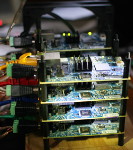
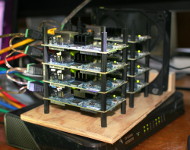
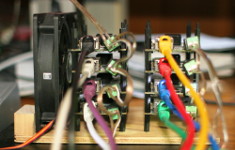
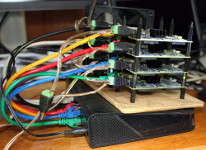
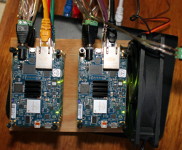
Comments
Comments powered by Disqus